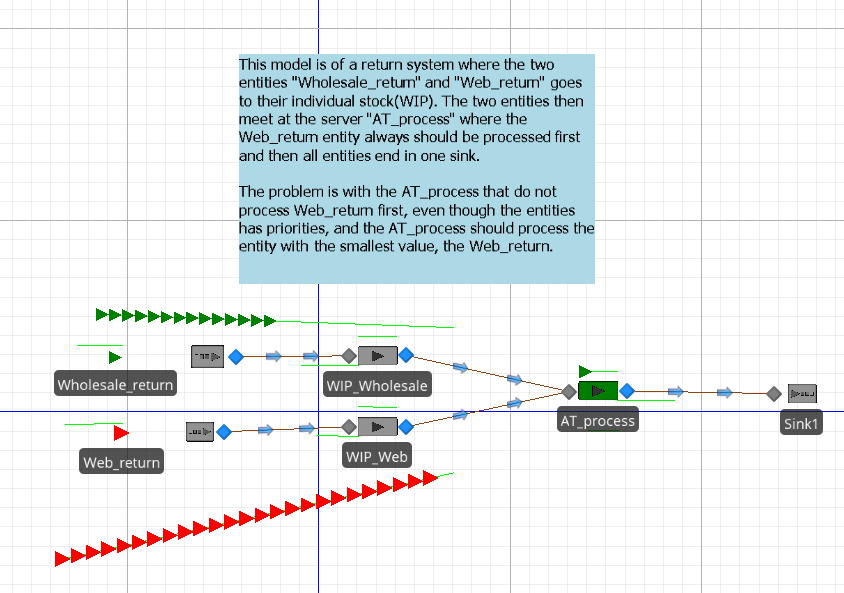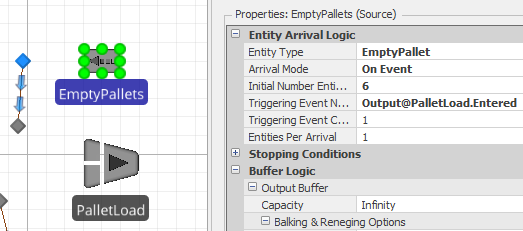Search the Community
Showing results for 'empty server'.
-

Two entities, where one always will be processed first
GFurtado replied to svend2000's topic in SI General Discussions
Entities are prioritized in server according to the server Ranking Rule. Check my attached model. I set Entity1 priority to 1, Entity2 priority to 2 and told the server to prioritize the ModelEntity with the highest priority value. You can play with that logic to prioritize everything the way you want. entity priority.spfx -
examining the simbit named Changing Queues When Server Fails will give you an idea on how to.
-
Hi everybody! I want to know if it is possible that an entity can change from one server to another if the another server is available and the entity isn't still processing. It means if it is possible that an entity can exit from the input buffer of the first server. Thanks for your help. Best, Albert.
-
Hello everyone, I am a master's student in operations management trying my hand at Simio for the first time. I want to develop a model that simulates the delays incurred by variable supply lead times which may lead to stock-outs at a manufacturing plant. I would like to model demand so that each entity generated by a single source module corresponds to a sales order. Each order should have a probability to include orders for several specific product types (since sales orders may contain orders for different product types). As such, entities should have an arrival rate which corresponds to the arrival rate of orders at the company, and the product mix of each order should reference the probability of a given product type being included in that order (i.e. product A has 25% probability to be included, product B has 50%, etc.). Is it possible to do this? I would also like for each product type to be associated with a specific BOM. I.e., a server module should reference each entity instance to consume material as defined by the BOM’s of the products stated by the entity instance. I have defined each component as material elements and defined a BOM for each finished product that references the materials needed. However, in the server module I am only able to input a specific type of finished product as material requirements... Your help is greatly appreciated!
-
After looking more into task sequences, it may work, but not without major rework, the primary issues are that the seizing is not the only thing that happens, and work will be done in phases, without moving from the server, and different patients may not have the same phases. I see how it could be done with a second model, but i'd like to avoid getting too complicated if I can Is it not possible to do what I asked in my original question?
-
You can use task sequences. Set process type property of a server as "Task Sequence". While populating processing tasks property of a server object (when you click on the three dots, that are seen at the right hand of processing tasks property, a repeating property editor will pop-up) you should use the same sequence number for all tasks you considered. Under Resource Requirements section of Processing Tasks-repeating property editor you have to input your resources (nurse, PA, doctor etc.). Examining some simbits related to task sequences will help you.
-
Within a Server, Combiner or Separator object, you can specify the Process Type as 'Task Sequence' allowing you then to define any number of Processing Tasks for that Server, Combiner or Separator. The processing tasks can be serial or parallel tasks. By using parallel tasks, for example, with a different worker (nurse, PA, Doctor) required for each parallel task, the tasks are done independently, but can be done at the same time. Parallel tasks can be specified using the same Sequence Number (see Task Sequence and Task Sequence - Processing Tasks sections of Simio help). So, for example, you can have the processing tasks within a Server all have a sequence number of 10 (meaning parallel). One of them requires a Nurse for X time units, another requires a PA for Y time units and the other a Doctor for Z time units). The patient doesn't leave the Server until all 3 tasks are completed. However, if the Nurse is available to do his/her task, they will start. Likewise for the others. And the workers can move on to other tasks at other Servers (patient areas) as well when they are done.
-
Visualize Utilization in Facility Window or Dashboard Reports I have a source – several servers – sink model. It’s a model of an assembly line production meaning that the entity cannot continue to Server 2 if Server 2 is occupied. The servers have different production times and I want to compare the different utilizations of the servers. I did this over the experiment window and the expression Server1.ResourceState.PercentTime(1) . In a next step I want to visualize these utilizations next each other with something like a bar chart. I came up with two possible ways of doing so but both didn’t work. In the facility window with the animation tools like the linear gauge. The problem here is probably that the expression “PercentTime” has no reference to what the overall time is, while the model is running, and therefore the gauge shows constant 100% the whole time. Or in the experiment window in the dashboard reports which doesn’t have percent time as a response. Is there any other way of visualizing the utilization?
-
I have an entity type. 50% of that entity is one counter type while the other 50% is two counter type. After the entity exits the server, 50% must exit while the other 50% must go to the second counter. How do i do this thanks
-
I have a system with 3 steps. At each step a certain amount of product is process and batched (using a combiner) on to a pallet. I have to assign a sequence table to the member entities and the parent (pallet) entities. However this is resulting in some batches sitting at a combiner because the pallet follows the sequence instead of going to the next batch ready if the pallet is empty. Any thoughts on how to handle this? If there is no call for an empty pallet the pallets could stay where they are or go to a specific location.
-
Hello, in general it sounds like your approach is good. You could use either an Object Reference State Variable or String State Variable (called something like 'WhichServer'), defined on ModelEntity, depending on the expression you use to make the assignment. For instance, with an Object Reference State Variable you could use 'ModelEntity.Location.Parent.Server'. With a String State Variable you would use 'ModelEntity.Location.Parent.Server.Name'. In terms of timing, you could make the assignment really anytime the ModelEntity is in the Server. You might use the Servers' On Entering State Assignments for example. Then somewhere downstream, perhaps the Entered Add-On Process at a Sink, you could use Add Row and Assign steps to populate the Output Table. Again, just be mindful to make the column types (Object Reference State Variable or String State Variable) match up with the assignments you are making. For instance you might have a String State Variable column named 'Entity' and, in the Add-On Process at the Sink, you assign 'OutputTable1.Entity' the New Value of 'ModelEntity.Name'. Then you could have an Object Reference State Variable column named 'Server' and in the same process assign 'OutputTable1.Server' the New Value 'ModelEntity.WhichServer' (since it is also an Object Reference State Variable). The result will be a list of each ModelEntity (Name) and the Server that processed it. Hope this helps! Adam
-
I tried to do the same thing but with sequence task in a server
-
Hi All, I have a query. Is there a way to implement logic that allows the model to vary the processing time of a server as a function of the available man power? In my model I have various servers and all need a specific number of workers in order to begin processing. I have one large pool of workers to be shared between all stations. This means that there are times when all the workers are in use and times when some are spare. Ideally I would like to model that when there are men spare they would come and help other stations and get the job done quicker or when only some of the required quota of workers are seized they can start the work all be it at slower pace until the full quota has been seized. I hope this makes sense Thanks
-
Add a state in your report using the State Statistic element. If you need that each server report its own state, it's best to create a custom server and add a State Statistic element inside it. Check the attached model for reference. State on report.spfx
-
Hello to everyone, How can I add final value to the result statistic for each server? Thank you in advance and best regards
-
New to Simio and learning as I go. The attached model includes a CombinerNode1 that batches entities in groups of 2 & 5 (random.discrete). I would like Server1 to use different processing times for the different batch sizes. For example, a batch of 2 entities should be processed in 5 seconds; Batches of 5 entities in 7 seconds, etc.. Eventually I will create batches of up to 6 entities. I have tried using Server1.Processing.Contents for Processing Time, but seems to return the value of 1 all times. Any help is appreciated! Thanks! Processing time based on BatchSize.spfx
-
Just curious if there's an easier way to go about doing this... Long story short if I am representing multiple physical positions within capacity of a server and I create my own Gantt outside Simio, it's important for me to know WHICH resource (in this case which one of the servers) is utilized by each entity. I was trying to utilize Entity.Location.Parent.Server.Processing.Contents.IndexOfItem( Entity ) and assigning it to a state on the entity and then ultimately writing to an output table. However, this doesn't seem to be working accurately. It may be a timing issue on when this step is called, but is there a default function I'm just not aware of that could be of assistance?
-
Varying Path Length and Moving Servers
gocken replied to DavidMann's topic in SI General Discussions
You can place some enough transfer nodes at different distances and directions (In freespace it will be hard to stop modelentity object and seize the server object. This can be quite challenging task). Then you can randomly send the modelentities to one of these transfer nodes (This is for sending entities some vector away from the source). Then, define an entered add-on process trigger for each transfer nodes and place a move step onto this add-on process. In resource movement request of this step define object type specific (or from list), object name any server (or from list you set), and destination node as the transfer node itself. Then, you can try seize step to or transfer step to send the entity onto server object. You have to try some options. -
I'm trying to model a towing company. A call comes either jump start or tow (entity 1 and 2) from two different sources. They go through a dispatch (server1) and get delivered to a specific driver (servers 2,3,4 or 5) . Each call coming in will have some exponentially distributed distance from origin associated with it (and direction component?) My challenges are: Is there a way to take and entity from a source and move it into free space some vector away from the source (distance and direction). Then, if that is possible, can I move a server to that location to process it (and if a tow then move some other vector distance after process). Finally, the ultimate goal of the model is to create a conditional routing logic for the dispatch server to compare distance from call and availability of drivers. Such that if a driver is finishing up near the next call, that server will take priority over the one with an empty queue if further away. TLDR: Can servers move? Is there a way I can change how long a path is based on variable input?
-
I ran your model until the warning occurs and then examined the Content and Throughput categories in your Results Pivot Grid. I didn't notice any alarming buildups in any of the Combiners, Conveyors, or Servers, but the Entity statistics appear unusual: None of your 3 entity types ever exit the system. Your problem is with creation of too many empty pallets. Another thing I noticed that could be the main problem is that your Empty Pallet source creates 6 empty pallets every .25 minutes, with no limit. When I converted this to a just-in-time (Event Based) creation the entity limit problem went away for that entity type: To answer your specific question, on the Project Home ribbon there is a place to open a Breakpoints window that allows a lot of flexibility to trigger a model break (pause) when a specific condition occurs. I hope this helps.
-
I have recreated a system to see theoretical capacities and it has multiple sources (1 parent and 2 different members that I combine). I have turned off balking because that interferes with my unit mix. I have also changed all buffers to a finite number and crossing logic capacities to 1. Even with all of this, I still hit the 2500 max entities and an error pops up. This system should only be able to hold a couple hundred, so I know I don't need to adjust my capacity size. I made the units stop at the 1st server so I could isolate the issue and it appears to be upon creation or in the combiner. My question is, how can I have unit production pause (not stop) when the buffers and capacities are full? I have attached the file for reference. APS Design 2.spfx
-
Hi, In my project, I have the (main) model of object type 'fixed' and a model of object type 'server'. In one of the processes executed by the model 'server', I want to add a search step that searches a specific entity in the entity population of the main model. How can I do this? Thanks in advance! Kind regards, Christa
-
Hi, I appreciate this information, but I have a similar situation and I am a bit confused by the answer. In this case for example, not sure what "stay post a delay" means. Does this imply a loop checking at intervals to see if a release condition is met, namely an OR is freed allowing completion of a state dependent process that frees the ER? It seems this logic might be common where availability of a downstream server blocks completion at an upstream service by blocking the space to process. I would be interested in seeing a simple example of the OR to ER logic model if someone has one or something similar. Thanks Much! Jim
-
Thanks for the reply! I think I have implemented this the way you are describing, but the closest of the two vehicle types, either MyVehicle or standard vehicle, is still being selected. If you have any other ideas, they would be greatly appreciated!! Now, I'm trying to play around with "Reserve Best" and a selection condition that might choose the closest of all possible candidate types. I've tried Candidate.Transporter.NetworkDistanceTo.Node(Output@Server) with selection goal of smallest value and this still just picks the closest of the two vehicle types.








